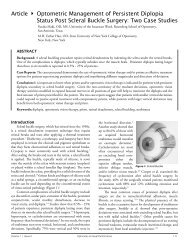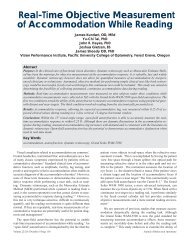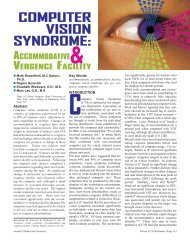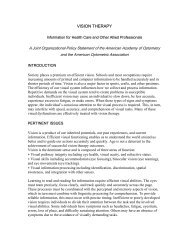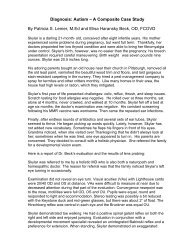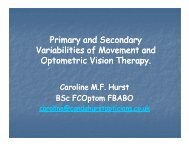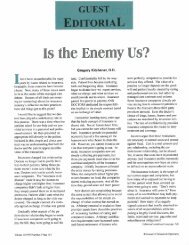Simon Grbevski.pdf
Simon Grbevski.pdf
Simon Grbevski.pdf
You also want an ePaper? Increase the reach of your titles
YUMPU automatically turns print PDFs into web optimized ePapers that Google loves.
• How is vision influenced by these?• Does the bodies structural/postural mechanismsaffect vision ii
• Why does one child develop normal binocular visualskills and another in similar environment doesn’t?• Why can a +8.00 Hyperope not developstrabismus but a +1.00 develop it?• Why does one person become myopic and anothernot?
• The presentation will show that dysfunctions inthe body posture, dynamics & structure andchanges to these can be directly related to ocular& visual problems.• Conversely Visual problems can be related tosystemic, body structural, postural & cognitivedysfunctions which with time lead todisorganisation & to disease.
• Skeffintons Model we see that all Sensesfeed into vision >visualisation• BUT Vision feeds back into all senses. Weare self stimulating!• Eg: From touch we > visual image of what thatobject is.• From the visual image we can remember whatit taste like.
• From the mental visual image we can selfstimulate and regulate our senses & body.• As demonstrated by Dr Ramachandras.As demonstrated by Dr Ramachandras.Phantom limb therapy using mirrors.
3 systems for understanding the world around us.Both externally & internal time & space.1. Vestibular ocular Reflex VOR V.O.R system2. Neck & head muscles – proprioceptive & musco‐skeletal system3. Visual system –Vision & relationship of ambient tofocal systems
• Idiopathic scoliosis i is often linked with poor balance.Vision is vital in the control of your posture as somestudies have shown that static postural performance is250% better with eyes open than when closed.• “The head dis the reference for the control of the bodyand therefore, it is imperative that when we examineall idiopathic scoliosis cases, we should be looking athow their heads are aligned on top of the spine andmisaligned”A t th b D Will K llAugust 12th, 2009 by Dr Will Kalla“Spinal corrective care”
Key points• Elliot Forrest E B : Astigmatism as function of visual scan, head scan,ans posture. Am J optom Physio Opt 1980• Astigmatism related to difference in the amount of head movementversus eye movement in the vertical & horizontal planes. The greaterthe difference the greater the astigmatism. More minus power in themeridian with relatively more head movement.• ie; the minus axis of cylinder more in the eye movement direction.• Astigmatism > forced eye movement scan in direction for survival.(Red Indian population Greater cylinder in horizontal axis.)• Shapiro J : Relation between Vertical facial asymmetry and posturalchanges of the spine and ancillary muscles.• Facial asymmetry: If the body wants to maintain good binocularvision the body compensates for the facial distortion by a head tilt >torticollis > scoliosis• IF the visual system makes the compensation (the disruption inocular function) then the body will not show the posturalmisalignment eg suppression.
• Body Stature and Myopia—The Genes in Myopia (GEM)Twin StudyAuthors: Mohamed Dirani ab; Amirul Islam a; Paul N. Baird ab• Conclusion: Females in the heaviest quartile of weighthave a significantly increased risk of myopia compared tothose in the lightest weight quartile in our twin studypopulation. Our study adds to the growing consensusthat anthropometric measures should be considered aspotential risk factors in myopia.• Effect of Stature and Other AnthropometricParameters on Eye Size and Refraction in a Population‐Based Study of Australian ChildrenElvis Ojaimi,1 Ian G. Morgan,2 Dana Robaei,1 Kathryn A.Rose,3 Wayne Smith,4 Elena Rochtchina,1 and Paul Mitchell1• This study found a strong association between• This study found a strong association betweenheight and axial length and corneal radius,
• 23. Catanzariti JF, Salomez E, Bruandet JM, Thevenon A.Spine. 2001 Jan 1;26(1):48‐52.• This study included 75 children who were visuallyhandicapped (mean age, 11 years and 7 months) and 728healthy control• five times more back surface abnormalities in the visuallyhandicapped . Of the 26 children with both visualimpairment and trunk deformity, 18 had a structuralscoliosis on radiographs, with an average Cobb Meyer angleof 14.1 degrees• (Harmon >12 degrees tilt > processing problems)• . Schutte B, Teese H, Jamison J: "Chiropractic adjustmentsand esophoria: a retrospective study and theoreticaldiscussion. " J Aust Chiro Assoc Dec 1989 19(4):126
• Neurology 80% of retinal fibres go to LateralGeniculate Body part of the Optic Thalamus ‐20% to Supra colliculus to which is part of themidbrain associated with posture.• Peripheral retina is designated d to the gyroscopicprocess of localisation & orientation of theinternal & external spatial organisation of theorganism.
• “Body Postural functions precede final central ocularresolution in satisfying the needs of the organism in anyvisual centred task” D.B. Harmon• Primary biological function of vision is related todetermining of space relations & space movements ofthe organism (for both orientation & localisation)Secondary is the higher function of abstraction &symbolisation of space & space movement for laterfacilitation and redirection of movement.D.B. Harmon
• If the body wants to maintain good binocular vision thebody compensates for the facial distortion ti by ahead tilt > torticollis > scoliosis• IF the visual system makes the compensation (thedisruption in ocular function) then the body will not showthe postural misalignment eg suppression.J. Shapiro
• Body balance, one of the primary survival mechanisms of the body, isaffected ectedby posture.• Posture is the window to the Spine• The balancing system of the body is comprised of the muscles of theneck, upper and Lower back, legs, and feet.• Human movement is produced by the skeletal acting as simple levermachines• The 4 skeletal pivotpoints of importance
• Peripheral vision and the semi‐circular canals of the innerear are intimately t related ltd neurologically ll to maintain i bodybalance.When either the semi‐circular canals or peripheral visionare thrown out of balance,tension results in the musculature of the body, usuallymore on one side than the other, and the bodycompensates to prevent falling.
• Unbalanced posture interferes with effective useof peripheral and binocular vision,• results in tension which then results in an adverseadaptation of the visual system to the demandsdof the task,• These adaptations ti are measured as verticalimbalances, myopia, high hyperopia,astigmatism, anisometropia, and fusiondifficulties.
• Visual system & posture are affected• When seated by• Vestibular Ocular system• Position of Pelvis• Position of neck• When standing upright by• Vestibular Ocular system• Position of neck• Position of Pelvis• Feet pattern
By Brooke CarrilloA Binocular problem or Refractive problemis depicted by a characteristic posturalpattern. These are translated in the body bythe posture of• The chin, (neck posture)•The shoulder extension,•The Pelvis hip position and•The feet patterns.
• Four key components• Skeletal System• Muscular System• Vascular System• Nervous ousSystem
• Skeltonstructureheld inposition bymuscularsystem
• Vertebrae similar tokinematic chain eachlink influences all theother links with greateston the adjoining links.
• From each vertebrae both nerve fibers and blood vessels leave toenter into the body supplying specific areas
Symptoms of TMJ include:An inability to open the mouth comfortablyClicking or popping sounds in the jawLocking of the jaw while opening the mouthHeadachesAn uncomfortable "bite"Shoulder, neck and back painFacial swelling
The eye sits in its orbit surrounded bycranial plates and parts of it pass throughhnarrow fissuresAny changes in the position of orbital bones orfissure size can affect function of eye!
CASE PRESENTATIONS ON THE AFFECT OFCHANGES IN SKELETAL POSTURESAFFECTING EYE FUNCTION & VISION
POINT OF CLARIFICATION• These cases are not to be viewed as a criticism of any of thetreatment modalities.• The severity and acuteness of the cases is used to demonstratethe extreme sensitivity of the structure function relationship.• Cases begin with a severe case leading to less severe todemonstrate that subtle changes in the structure can result indemonstrate that subtle changes in the structure can result insubclinical symptomatic changes in vision.
Case 1• CN: Male 40’s• Cranial adjustments for tight cranialplatesResulted in Central retinal vessel occlusion
CASE 2• Female early thirtiesti• Pregnant• Last semester of pregnancy• Hip gave in became bed ridden unable to walk or stand• Sudden vision loss & restriction in field• Investigation ; neurologist neuroophthalmologistSuspect: Pituitary tumorCranial & Chiropractic AppliedCranial & Chiropractic AppliedKinesiology
CASE 3• Female mid 40’s• Chirodontics for scoliosis• Bite built up 6mm• Sudden removal of built up material.
eforeafter
CASE 3 continued…• Symptoms experienced post removal andattempts to relieve symptomsMacula hemorrhagesVisual discomfort an blurred visionDisorientation
CASE 4• Female mid 40’s• Car accident whiplash• Moderate Hyperopic astigmat for about 30yrs• (R+2.50‐2.00x180 L+2.00‐1.25*180Axis flipped to 90
CASE 5• Male age 37• 2005 Rx R+1.00‐0.50x3 L+1.00• 16/8/2007 Check up• lft left wisdom id tooth th problems & inflamed• New Rx R+1.00‐1.00*45 L+1.75‐0.75*105 Dist Ph3s/1BULE• Review 2/10/07Rx R+1.25-0.50*45 50*45 L+1.25-0.50*10550*105Dist Ph: 2s/0
CASE 6• Female 50’s• Base cerebellum bone removed• Resulted in chronic double vision• Plastic plate implanted to reduce vertical helpedbut not totally• Syntonics & VT given to relieve rest
RECAP• Cranial plates can affect eye function.• TMJ greatest affect of all skeletal system onsensory function (vision/vestibular)• Lobe rail 11 degree tilt adjusts spine• Harmon >12degree head tilt will affectperception.• Yawning releases tension in TMJ > greaternerve & blood flow
DON’T FEEL OVERWHELMEDRelax enjoy the View



